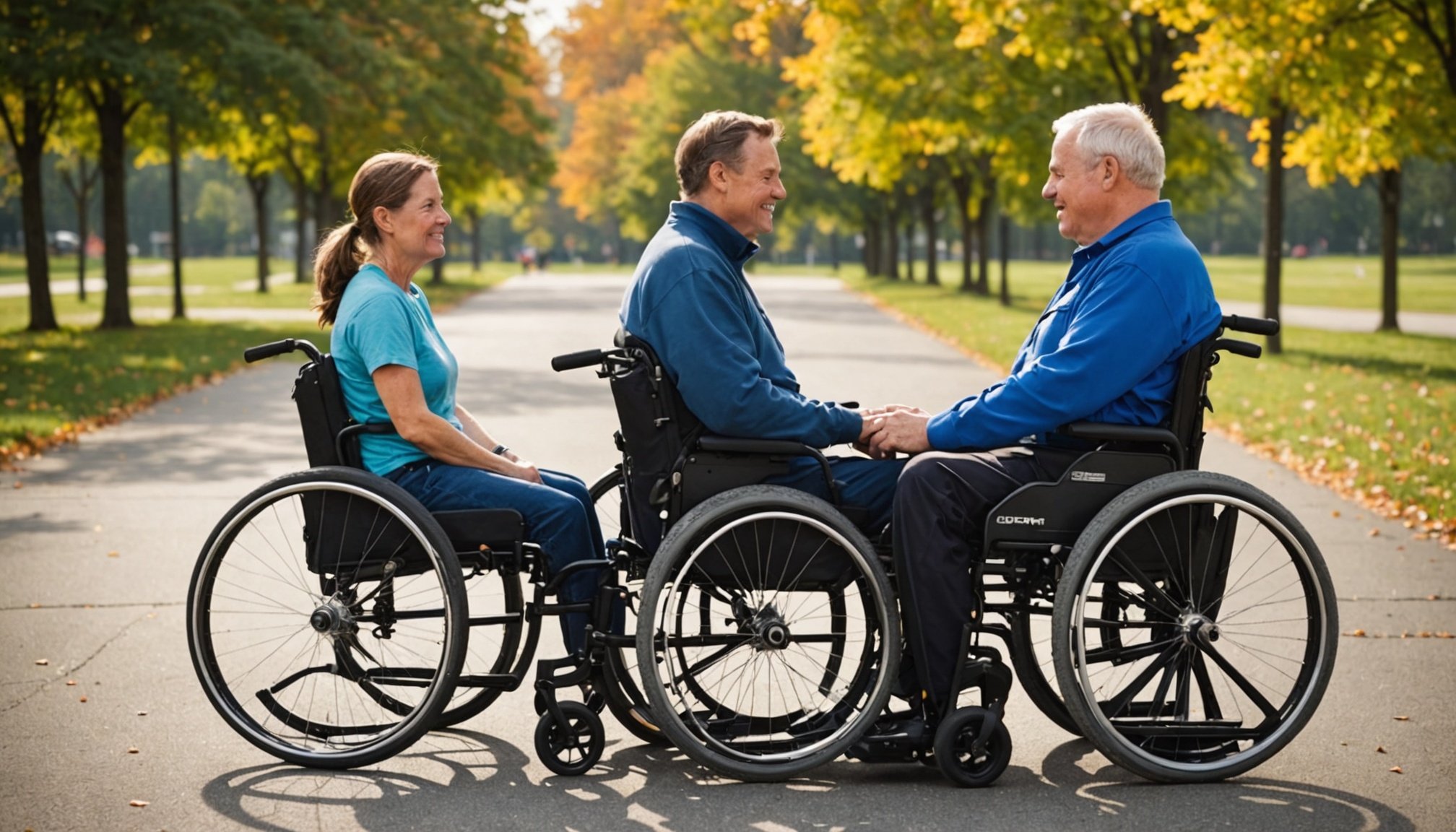Understanding Adaptive Equipment
Adaptive equipment encompasses a wide array of accessibility tools and mobility aids, each designed to enhance everyday life for individuals with challenges. These tools are vital in promoting autonomy and improving quality of life.
Accessibility tools range from simple items like grab bars and sensory aids to sophisticated technologies such as voice-activated software. These tools allow individuals to perform tasks independently, boosting confidence and self-reliance. Conversely, mobility aids include canes, walkers, and wheelchairs, crucial for those with movement difficulties. They facilitate safe and efficient travel, reducing the risk of falls.
In parallel : Empowering women: proven techniques to boost bone density during menopause – your complete guide
Understanding adaptive equipment’s function is essential for selecting the right aids. For example, grab bars installed in bathrooms provide stability, while screen readers can assist those with visual impairments in accessing digital content.
Integrating these tools into daily routines is key to leveraging their benefits. Adaptive equipment not only enhances personal independence but also simplifies caregiving by reducing physical demands on caregivers. Ultimately, the aim of adaptive equipment is to empower individuals, allowing them to lead fuller, more inclusive lives within their communities.
Also read : Ultimate guide to mastering chronic bronchitis: effective strategies for symptom relief
Practical Tips for Use
For effective usage of adaptive equipment, it’s crucial to implement adaptive strategies that mesh seamlessly with user routines. First, gradually familiarise users with their devices. Start with supervised sessions to build confidence and competence. Ensuring adaptive devices are intuitive can greatly enhance the overall user experience, fostering independence.
Maintenance is another important factor. Regular checks can prevent common issues. For instance, pay attention to the battery life of mobility aids such as electric wheelchairs; troubleshooting minor problems promptly can help avoid disruptions. Troubleshooting tips, which might include checking connections or adjusting settings, can be indispensable.
Integrating equipments into daily life requires consistency. Establish routines to promote comfort with devices—for example, schedule times when using specific accessibility tools becomes part of a daily habit. Routine practice solidifies familiarity and ensures that users are comfortable managing these tools independently.
As adaptive strategies are refined, users often experience improved engagement in their everyday activities. Encouraging a synchronized approach between users and caregivers further enhances the success of deploying these tools. Tailored strategies can transform the user experience from overwhelming to empowering, thereby maximizing the utility and benefits of adaptive equipment.
Product Recommendations
In the realm of assistive technology, choosing the right adaptive devices is paramount in addressing diverse disabilities. Identifying top-rated products helps streamline the selection process. For mobility, the KneeRover Steerable Knee Scooter is celebrated for its stability and ease of use, while the Permobil F5 VS electric wheelchair offers unique standing functionality and customisable seating. Each model enhances physical mobility promptly and reliably.
Accessibility tools are invaluable as well. The Amazon Echo Show stands out for its voice-activated features, aiding those with visual impairments. Pairing this with smart home technology creates a user-friendly environment, promoting independence.
Comparative benefits should inform your choice. Could the size or weight of a device be a concern? Devices like the iRobot Roomba blend convenience with simple controls, reducing the physical effort of maintaining home cleanliness.
User testimonials often highlight improved daily functioning and emotional well-being. For instance, one user describes how transitioning to an electric wheelchair not only facilitated mobility but also boosted social interactions and participation in community activities. By focusing on recommended products, you’ll find the assistive technology best suited to your needs, integrating smoothly into your lifestyle.
Empowerment through Real-Life Applications
Empowerment stories often highlight the profound impact of adaptive equipment on individuals’ lives. A compelling case study illustrates how mobility aids, like the Permobil F5 VS electric wheelchair, empower users by enhancing their independence and social interaction. For example, John, who once struggled with mobility due to a spinal injury, now participates actively in community activities and experiences renewed social engagement.
Personal stories provide powerful insights into the transformative capabilities of these tools. Emily, a young professional with visual impairment, found accessibility tools, such as screen readers, essential for career progression. Her productivity and confidence in the workplace improved significantly, highlighting the importance of adaptive devices in professional settings.
For caregivers, witnessing the empowerment these tools afford to their loved ones is equally rewarding. User experiences suggest that adaptive equipment aids not only those who use them directly but also their support networks. This mutual empowerment fosters a positive environment where both users and caregivers thrive together.
Ultimately, these real-life applications of adaptive equipment underscore its critical role in enhancing quality of life. By embracing these devices, individuals can achieve greater autonomy and a more inclusive presence within their communities.
Understanding Adaptive Equipment
Adaptive equipment is an expansive category that includes both accessibility tools and mobility aids, each serving distinct functions to improve users’ lives. These tools play a pivotal role in promoting autonomy and enhancing the quality of life for those facing various challenges.
Accessibility tools encompass a range of devices from straightforward grab bars to advanced tech solutions like voice-activated systems. They empower individuals by enabling independent task completion, boosting user confidence and self-reliance. On the other hand, mobility aids such as canes, walkers, and wheelchairs are essential for anyone experiencing movement difficulties. These aids not only facilitate secure and efficient travel but also significantly lower the risk of falls and related injuries.
Having a thorough understanding of these tools is crucial for selecting the appropriate aids to meet individual needs. For instance, grab bars in bathrooms offer essential stability, whereas screen readers help those with visual impairments access digital content easily. Integrating these tools into daily life is vital to harnessing their full potential, ultimately empowering individuals to lead more inclusive and fulfilling lives within their communities.
Resources for Further Support
Access to support resources is crucial for individuals and caregivers navigating adaptive equipment. Online resources offer comprehensive guides and instructional videos to aid users. Websites like RNIB provide valuable training guides that cover a wide range of equipment, from screen readers to mobility aids.
In addition to digital tools, community resources are integral to support. Many community organizations, such as AbilityNet, provide in-person workshops and seminars, which can greatly enhance understanding and proper usage of adaptive gear. These organizations often act as a bridge, connecting individuals with similar challenges and fostering a supportive network.
Moreover, joining support groups can offer emotional and practical advice. These groups facilitate knowledge exchange among users and caregivers, sharing experiences with adaptive technologies.
For caregivers, training guides specifically tailored to their needs are essential. They focus on equipping caregivers with skills required to maximize the benefits of adaptive devices for their loved ones, ensuring safety and boosting confidence.
Whether through online resources, community networks, or dedicated support groups, gaining access to these resources can significantly improve one’s ability to effectively use and integrate adaptive equipment into daily life.











